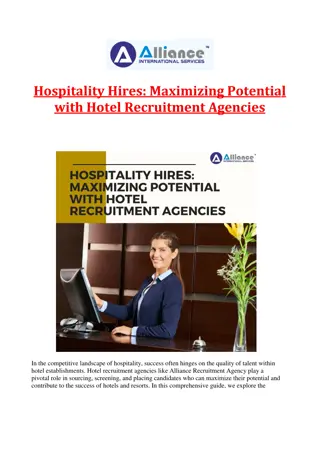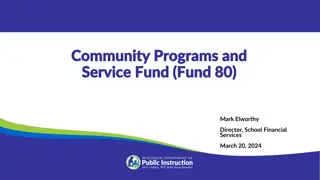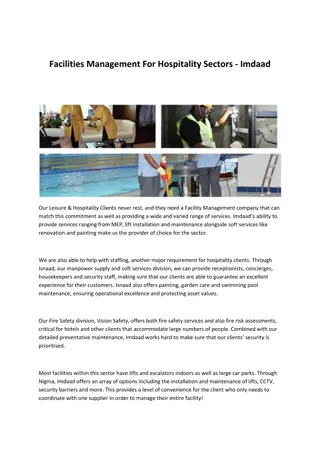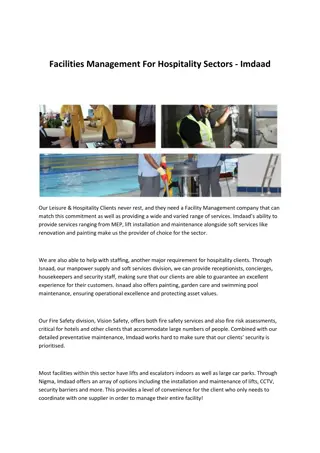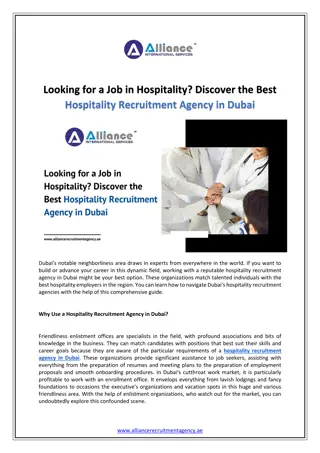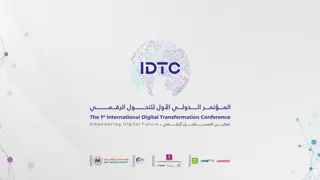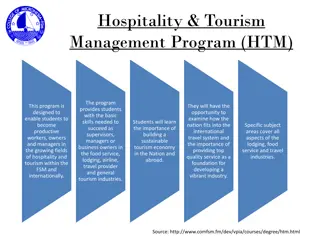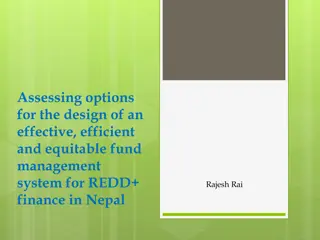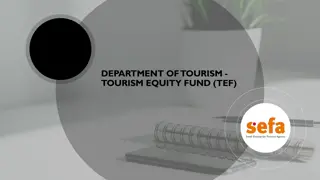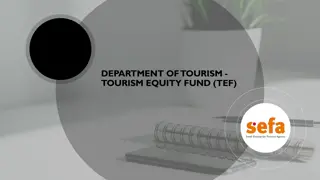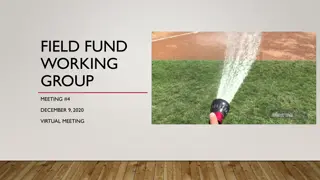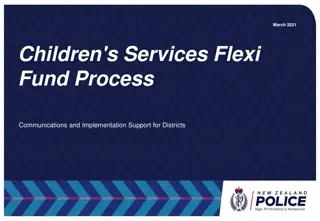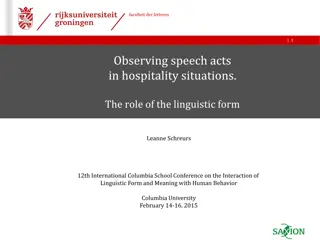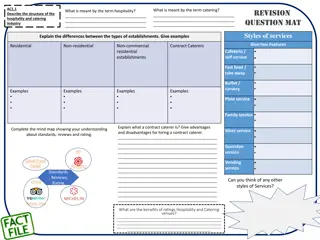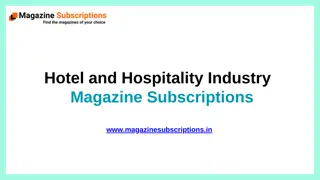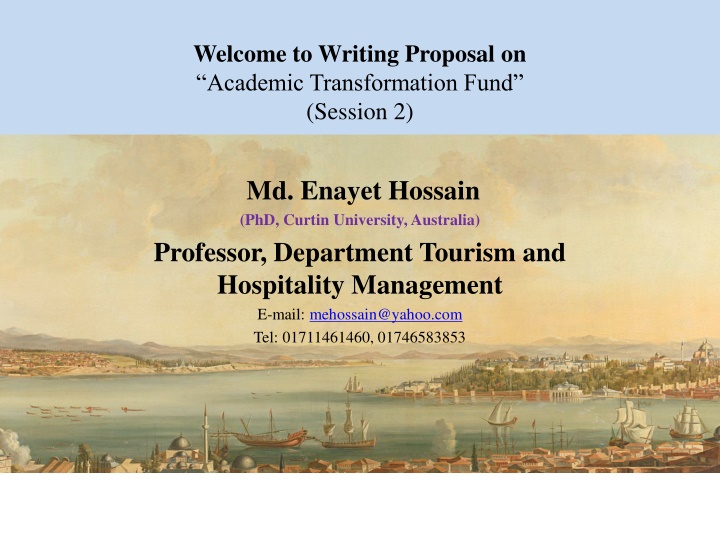
Academic Transformation Fund Proposal for Hospitality Management
This proposal aims to enhance academic standards in Hospitality Management through the Academic Transformation Fund. Led by Professor Md. Enayet Hossain, the project focuses on capacity building, industry collaboration, and promoting youth employment. Components include budget details, operations plan, and sustainability measures. The goal is to bridge academia and industry to empower graduates with employability skills in Bangladesh.
Download Presentation

Please find below an Image/Link to download the presentation.
The content on the website is provided AS IS for your information and personal use only. It may not be sold, licensed, or shared on other websites without obtaining consent from the author. If you encounter any issues during the download, it is possible that the publisher has removed the file from their server.
You are allowed to download the files provided on this website for personal or commercial use, subject to the condition that they are used lawfully. All files are the property of their respective owners.
The content on the website is provided AS IS for your information and personal use only. It may not be sold, licensed, or shared on other websites without obtaining consent from the author.
E N D
Presentation Transcript
Welcome to Writing Proposal on Academic Transformation Fund (Session 2) Md. Enayet Hossain (PhD, Curtin University, Australia) Professor, Department Tourism and Hospitality Management E-mail: mehossain@yahoo.com Tel: 01711461460, 01746583853
Components for Proposal Writing 1. Proposal title 2. Implementation Period 3. Total cost: BDT & US$ 4. General objectives 5. Specific objectives 6. Sub-project summary 7. Strategic Analysis 8. Background Data Substantiating the Strategic Analysis 9. Description of proposed field of research 2
Proposal Components 10. Table of Milestones (Annex-1) Table Performance Indicators (Annex-1) Table of Logical Framework (Annex-1) 11. Relevance 12. Benefits (Qualitative and Quantitative) 13. Operation & Maintenance of Equipment/ Instrument 14. Summary of Estimated Budget 15. Work/Activities Plan (Annex-2) 16. Financing Plan (Annex-3) 17. Procurement Plan (Annex-4: Tables A-E) 18. Training Plan (Annex-5) 3
Proposal Components 19. Detail Budget (Annex-6) 20. Technical assistance/consulting 21. Linkages/collaboration 22. Effect/impact of the sub-project 23. Sustainability 24. Environment Safety Checklist & Mitigation Plan (Annex-7) 25. Social Screening Form (Annex-8) 26. Experience in similar project 4
Proposal Title Informative, not creative Brief, precise, direct & comprehensive Reflect objectives Should include all known keywords Institutional and project responsibilities should be well established Complete at the end of writing EXAMPLE Capacity Building of Hospitality Graduates in Bangladesh to Promote Youth Employment Through industry and Universities Partnership Alternative: Empowering Tourism and Hospitality Graduates in Bangladesh: Bridging Academia and Industry for Employment Or Development of Employability Skills of Hospitality Students through Academia and Industries Partnership 5
Window 3b: Collaborative Research with Industries Institutes and Research Activities: University-industry collaborative research targeting patenting and commercialization of research products. Eligible Entities: Departments/Institutes of all eligible Universities Budget Limit: :BDT. 200-1000 Lac 24 24
Implementation Period (EXAMPLE) i. Implementation Period: 03, Years) ii. Commencement: January 2025 iii. Completion: December 2027 Ex. June 2028 Total cost: BDT & US$ (i) (ii) BDT: 600 lack or 6 corer) US$500000(@ 120 BDT as on Jan 1, 2025) 7
General objective/s Should reflect the title; Repeat keywords if possible Should be commensurate with vision, mission, goal of the University, entity State main problem addressed by the proposal State objectives referred to medium-term results and impact that the institution would like to achieve Single Sentence 8
Example General Objective The general objective of the study is to empower tourism and hospitality graduates in Bangladesh by bridging the gap between academia and industry, ensuring they are equipped with the skills, knowledge, and experiences necessary for successful employment in the local and global markets.
Specific objectives Should support the General Objectives Several specific objectives against one General objective Identified and numbered Clear and Specific Measurable, not necessarily quantified Achievable during lifetime of the project but outreach beyond Relevant in the local context Should allow periodic M&E 10
Example Industry Collaboration: To establish strong partnerships with tourism and hospitality organizations for internships, mentorship, and job placement opportunities. Global Competency: To prepare graduates for international markets by integrating global best practices, foreign language training, and international certifications/recognition. Entrepreneurship Development: To foster entrepreneurial skills among students, enabling them to create innovative tourism and hospitality businesses in Bangladesh. Research and Innovation: To promote research and innovation in tourism and hospitality, addressing both local and global challenges and contributing to industry advancements.
Institutional information Information importance of the Department/institute. It would be wise to emphasize the relevance of the project (implied) should be based on the 12
Example The tourism industry is considered as one of the largest and the most diverse industries in the world. It has been drawing attention as a modern service industry and the device to create connectivity among nations and various people across the world. This industry has the most potential in the world. Every 1 in 10 jobs; generating 10% of global GDP and 9 % of the world s jobs are part of this industry. Currently there are more than 5 million jobs available in the world; and roughly 0.5 million jobs are in Bangladesh. It is expected that by 2022 more than 2.5 million jobs will be created in Bangladesh in this field. The estimated statistics indicate that there are many possibilities and potentials existing in our country as well as abroaod. Unfortunately, due to the lack of strategic attention, tourism industry has not shown considerable progress.
Example only The economy of the country is growing at over 7%; the government has set a target of over 8% economic growth in the next fiscal year and employment generation will be 15 million within next five years. Obviously, tourism industry will play significant role for fulfill these targets. The Department is also committed to achieve quality and to establish an effective system that helps in elevating the educational process, in reaching the department to leadership. It wants see itself as iconic department through an even balance between theoretical and practical expertise, while also keeping aligned with the labor market to promote tourism industry in a way that goes with the Bangladesh status regionally and globally.
Proposal Summary 250 words for SPP A first concise view of the proposal Follow logical framework approach a. Goal & Purpose General Objectives b. Purpose & Output Specific Objective Expected Result Outcome c. Output & Input Activities, Methods etc. Item-wise paragrapgh captions 15
PROPOSAL SUMMARY (EXAMPLE) Tourism and hospitality are rapidly growing sectors with significant economic potential. However, a gap between academic teaching and industry needs hinders graduates success. This project aims to bridge this gap by aligning curricula with industry requirements, incorporating practical skills, and fostering global competencies. The project emphasizes hands-on training, industry-led internships, and strong academia-industry partnerships, both locally and internationally. Key areas include global acceptance, language training, international exposure, sustainability, ethical practices, and entrepreneurship. The goal is to enhance graduate employability, support economic growth, and position Bangladesh as a competitive destination in the global tourism and hospitality market.
Strategic Analysis - Basically, SWOT analysis - Should clearly indicate that all categories of stakeholders participated in the exercise - Both internal (strength & weaknesses) and external (opportunities & threats) factors should be analyzed & highlighted -Link SWOT results with: objective, activity, outcome, performance indicator 17
Strategic Analysis (SWOT) Strength Weakness Internal Opportunities Threat External 18
STRENGTH ANALYSIS EXAMPLE Bangladesh's tourism and hospitality industry is expanding, offering significant job opportunities for skilled graduates. A large and dynamic young workforce eager to contribute to the sector. Several universities and training centers offer tourism and hospitality programs, providing a foundation for skill development. In Bangladesh there are around 42 universities are offering this program. Bangladesh Government also recognizes tourism as a key sector for economic growth, ensuring policy support for workforce development. Thus, this sector have a lot potentially in home and abroad. However, in the flowing sections partially a brief description is given focusing SWOT.
STRENGTH ANALYSIS EXAMPLE 1. Growing Tourism Sector: Bangladesh's tourism and hospitality industry is expanding, offering significant job opportunities for skilled graduates. 2. Youth Demographics: A large and dynamic young workforce eager to contribute to the sector. 3. Established Academic Institutions: Several universities and training centers offer tourism providing a foundation for skill development. 4. Government Focus on Tourism: The government recognizes tourism as a key sector for economic growth, ensuring policy support for workforce development. 5. Untapped Potential in Sustainable Tourism: Opportunities in ecotourism, cultural tourism, and heritage tourism that graduates can capitalize on. and hospitality programs,
WEAKNESS ANALYSIS EXAMPLE 1. Skill Mismatch: A gap between academic training and the practical skills required by the industry. 2. Limited Industry-Academia partnerships between universities and industry stakeholders for internships, training, and curriculum development. 3. Outdated Curriculum: Course content may not keep pace with evolving industry trends and global standards. 4. Lack of Soft Skills Development: Deficiencies in communication, leadership, and customer service skills among graduates. 5. Employment Challenges: High underemployment rates due to limited job opportunities aligned with graduates' qualifications. Collaboration: Inadequate
OPPORTUNITY ANALYSIS EXAMPLE 1. Global Trends in Hospitality: Increasing international interest in Bangladesh's tourism sector opens doors for innovative and global- standard training programs. 2. Technology Integration: Leveraging digital tools and online platforms for both education and industry engagement. 3. Policy Interventions: Government policies and incentives can stimulate industry-academia collaboration training programs. 4. Public-Private Partnerships: Collaborative ventures between academia, industry, and policymakers to bridge the employment gap. 5. Regional and Cultural Strengths: Rich cultural heritage and natural attractions provide a unique advantage for specialized training and niche tourism markets. and investment in
THREAT ANALYSIS (EXAMPLE) 1. Political Uncertainty: It could be raised on the way of implementation of the project that may make delay. 2. Economic Uncertainty: Fluctuations in economic stability can impact the demand for tourism and hospitality services. 3. Global Competition: Competing with well-established tourism markets in the region for skilled jobs and investment from the wider. 4. Lack of Awareness: Limited understanding among stakeholders about the importance of aligning education with industry needs. 5. Brain Drain: Skilled graduates may seek opportunities abroad due to better pay and prospects, leading to a talent gap locally.
Background Data -Should link the background data with SWOT (S & W part) -Should generate extra relevant information along with the given questions -Data should relate to the sub-project issues -Some quantitative facts about the entity -Some important items not to be omitted: Basic academic indicators (input, output, outcomes); physical facilities, institutional tendencies Note: SWOT analysis & background data should be related 24
(EXAMPLE) According to the World Travel & Tourism Council (WTTC), the tourism sector in Bangladesh contributed BDT 1.02 trillion (USD 9.5 billion) to the country s GDP in 2023, accounting for 3% of the total employment in Bangladesh, with 2.14 million jobs. A Bangladesh Bureau of Educational Information and Statistics (BANBEIS) survey shows that only 40% of tourism and hospitality graduates find jobs within six months, with employers citing a lack of practical skills and industry exposure as major barriers. United Nations World Tourism Organization (UNWTO) highlights the global shift toward sustainable and digital tourism, which demands proficiency in areas such as technology integration, sustainability practices, and cross-cultural communication.
(EXAMPLE) A 2021 study by the Bangladesh Institute of Development Studies (BIDS) found that less than 30% of academic institutions have active partnerships with industry stakeholders, resulting in limited opportunities for internships, on-the-job training, and industry- aligned recognitions. Furthermore, the lack of entrepreneurship development programs within academic institutions restricts graduates potential to create innovative tourism ventures. This is critical in a market where micro, small, and medium enterprises (MSMEs) drive local tourism growth.
DESCRIPTION OF PROPOSED FIELD OF RESEARCH (EXAMPLE) There are multiple career opportunities in this industry like managing hotels, resorts, restaurants, public houses; conference hall, accommodations, catering services, customer services, and management access a range of industries. Jobs are also available in airlines, cruises, hospitals, transportation services, spa, beauty- parlor destination planning, designing and development .The leisure industry also covers sport and entertainment as additional avenues of employment in sport and fitness centers, cinemas, and theatres as well as other leisure venues such as bowling alleys and theme parks. Other service-focused roles in retailing, human resources management and events management also could be of interest areas. Many become on entrepreneur in the services industry like tour entrepreneur, club, travel, event, restaurant, hotel owner and several others. While we are committed to achieve global excellence in tourism and hospitality education, we continue to forge strong relationship between the industry and students, academic and non-academic staffs, partnerships through industry collaboration and effective teaching and research.
DESCRIPTION OF PROPOSED FIELD OF RESEARCH (EXAMPLE) 1. Academia-Industry Gap: Curricula often fail to address the real- world challenges and practical requirements of the industry. 2. Skill Deficiency: Employers frequently report a lack of soft skills, technical expertise, and leadership qualities among graduates. Limited Industry Collaboration: A lack of partnerships 3. between educational institutions and industry stakeholders restricts students opportunities for internships, apprenticeships, and hands-on learning. Underutilization of Educated Human Resources: The 4. mismatch between the skills acquired by graduates and the needs of the industry leads to underemployment and unemployment.
Project Indicators Level 1. Milestones Describe progress in sub-project implementation Expressed in terms of critical activities/outcome Level 2. Performance indicators key variables that affect beneficiaries Refer to Annex-2 of ATFOM Logical Framework Essential for M&E, measurement of achievement of results, effectivness in resource s use and improvement of project design. 29
Milestones (Level 1) Achievement of critical activities / Results Only critical activities & critical results Activity-Result relation should be well visible and self explanatory Should indicate a new level in implementation Must be objectively verifyable Relate to Work plan, Procurement plan, Financing plan 30
Milestones (Level 1) EXAMPLE To prepare graduates for employment in Bangladesh and the global tourism and hospitality industry, a structured approach with clearly defined milestones is essential. Below are key milestones and specific activities to achieve them are given in briefly: Area 1. Curriculum Modernization and Industry Alignment Milestone: Develop a curriculum that aligns with both national and international industry standards. Activities: 31 Conduct a needs assessment by consulting industry stakeholders, alumni, and employers. Integrate practical modules such as event planning, tourism marketing, hotel operations, and travel technology. Offer specialized courses in emerging areas like sustainable tourism, eco- tourism, and digital marketing. Align the program with global certifications like the World Tourism Organization s TedQual accreditation.
Milestones (Level 1) EXAMPLE Area 2: Skill Development through Practical Training Milestone: Equip students with industry-relevant technical and soft skills. Activities: Establish state-of-the-art laboratories such as mock hotel rooms, kitchens, and reservation systems and house keeping services. Partner with local and international organizations to provide internships and apprenticeships. Organize workshops and seminars on communication, customer service, cultural sensitivity, and problem-solving skills. 32
Table of Milestones (Example from HEAT) Milestone Specific Objective Critical activities Verification method Assumption ATFOM published Teaching learning, research Manuscript printing contract Physical, Record Sufficient no. of tenders ATF started -Do- Proposal call evaluation contract sign List of sub- projects All time schedule maintained BDREN first phase High speed Internet Design Fiber laying NOC creation Physical No administrative hindrance Univ. coop-n 33
Performance Indicators (level 2) Relation between milestones & performance indicators, log frame Log-frame: Input Output Purpose Goal Performance Indicator Milestone -May be within the SPP period, some may go beyond -May be quantitative and qualitative (but verifiable) -Assumptions should be realistic -Verification methods clear, operational -Refer to general objective, specific objectives, benefits, University characteristics etc. 34
Table of PI (Example from HEAT) Indica -tor Specific objective Cal. meth od % Assump- tion Verif. method Cal. base value % Base value 2024 **** Desire d value 2026 **** Devt. of new curricul um Teaching- learning Academic Council Approval M&E report Student access to Internet High speed Internet % Sufficient internal connec- tivity Survey % **** **** 35
Relevance Explicit: University & Entity relevance (eg. Agri Univ. projects should be agri related) Regional relevance National relevance Relate to sub-project activities, specific objective, SWOT results 36
Relevance (EXAMPLE) 1. Employment Challenges for Graduates: Tourism and hospitality graduates in Bangladesh face difficulties in securing jobs that match their qualifications due to a lack of industry-specific skills and practical experience. 2. Sectoral Growth and Economic Contributions: Tourism and hospitality contribute significantly to Bangladesh s GDP and provide direct and indirect employment opportunities. 3. Meeting Industry Demands: The rapid growth of sustainable tourism, digital technologies, and globalized markets demands a workforce with diverse skills, including technology integration, sustainability practices, and cultural adaptability.
Benefits(qualitative and quantitative) Be imaginative but objective Direct and indirect benefit Relate to general objective, specific objective Relate to performance indicators Some examples Better R&D infrastructure and capacity Wider PhD disciplinary coverage, enrolment and graduation Higher research outputs, productivity and international linkages 38
Qualitative Benefits (EXAMPLE) 1. Enhanced academic training with industry requirements, graduates will possess the relevant skills and practical experience needed to meet employer expectations. This will boost their confidence and readiness for the workforce, allowing them to transition smoothly from education to employment. 2. Strengthened Academia-Industry Establishing partnerships between educational institutions and tourism and hospitality businesses fosters mutual learning and collaboration. These relationships ensure that the curriculum stays relevant and responsive to industry demands, benefiting both students and employers in the long term. Employability of Graduates: By aligning Relationships:
Quantitative Benefits (EXAMPLE) 1. Increased Graduate Employment Rate: By bridging the gap between academia and industry, graduate employment rates are likely to increase. For example, the percentage of graduates securing employment within six months of graduation can rise from the current 40% to 70% or higher, reducing unemployment in the sector. 2. Higher Salary and Job Placement Rates: Graduates equipped with industry-relevant skills and experience are more likely to command higher salaries. This can result in increased average salaries for tourism and hospitality graduates, with potential increases in salaries by 15-30% as they fill key positions in industry-leading organizations.
Proposal Sustainability Continuation after the contract can be foreseen and is realistic Capitalisation on previous experiences Medium/long term impact can be expected Long-lasting effect on institutions/target groups Environmental, safety hazard protection and risk mitigation have been considered Institutional commitments on implementation and sustainability are clear and convincing 41
Proposal Sustainability (EXAMPLE) 1. Establishing Long-Term Academia-Industry Partnerships Action: Build continuous and strategic partnerships with key industry stakeholders, including hotels, government tourism bodies. airlines, travel agencies, and Sustainability Mechanism: Forming advisory boards consisting of industry leaders who actively participate in curriculum development, internship programs, and job placements. Regular review meetings and partnership contracts will ensure that both academia and industry stay aligned with evolving market trends. Outcome: Ongoing collaboration between institutions and employers will ensure that industry requirements are continuously reflected in academic programs, while providing students with continuous access to internship, industrial attachment and employment opportunities. 42
Proposal Sustainability (EXAMPLE).. 2. Curriculum Flexibility and Global Integration Action: Continuously revise the curriculum to reflect global trends, digitalization, and sustainability while also maintaining flexibility to adapt to emerging industry needs. Sustainability Mechanism: Develop strong collaborations with international academic institutions, ensuring that curricula remain globally competitive. Offer exchange programs and online learning platforms to allow students to engage with global trends. Outcome: The curriculum will be continuously updated to keep pace with industry demands, ensuring that graduates are always prepared for global job markets. International exposure and certifications will further increase the employability and competitiveness of graduates.
Operation and Maintenance of equipment and instruments Institutional capacity in operation and maintenance of instruments that will be used in the project: In-house preventive maintenance In-house servicing Repair parts (if any) Externaly procured servicing equipment and
Summary of Estimated Budget (Aggregate and Detail) Detail and aggregate are structurally related Detail first and Aggregate will follow Employ New Economic Code (7-digit; SPP Annex-3) Prepare in Excel Sheet Comply ceiling and rates e.g. SPM team incentive, Consultant hire, Renovation, etc. Ph.D., MPhil scholarship, Training, Collaboration, Foreign visit, etc. 45
Workplan: Actions in time chart (Gantt chart) Work plan should be progressive and realistic Activities should be logically sequenced Where, when and who questions should be answered Clear milestones should be set Duration of preparation versus implementation should be realistic 47
Workplan: Actions in time chart (Gantt chart) EXAMPLE Activities Year 1 Year 2 Year 3 1 2 3 4 5 6 7 8 9 10 11 12 1 2 3 4 5 6 7 8 9 10 11 12 1 2 3 4 5 6 7 8 9 1 1 1 1 2 0 x x x x ATF s Office Setup ( Renovation, Furniture, office staff appointment) Procurement of Computer and accessories Procurement of Electric Equipment x x x x x x x x Website Development Publication on Research Findings x x x x x x x x x x x x x x x Training (Non-AC) x x x x x x x x x x Training (AC) x x x x x x Training (Foreign) x x x x x Seminar x x x Workshops x x x Study Tour at Home x x x ATF (phase-1) x x x x x x x x x x x x Self Assessment (phase-2) Self Assessment (phase-3 x x x x x x x x x x x x x x x x x x x x x x x x Reporting x x x x x x x x x x x x x x x x x x x x x x x x x x x x x x x x x x 48
Training/Workshop Plan Training for Human Resource Development of the Entity Types: Training, Workshops Location: Local & Foreign Should be logically sequenced Academic staff upgrading Academic staff development. Post-graduate degrees, local and abroad. New qualified staff Support/ management staff, Technicians 50




